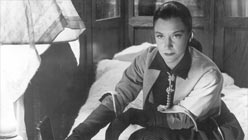In Blood of a Poet, the first film in Jean Cocteau’s Orphic trilogy, photographer Lee Miller stars as a statue who comes to life. Other images in the film include people using mirrors as doors between life and death, a mouth appearing on the poet’s palm, and a well dressed couple playing cards in the snow while a boy bleeds at their feet, so a statue who starts talking and offering advice seems perfectly reasonable. The whole movie has a dreamy quality and what happens makes sense in the same way our dreams make sense.
The San Francisco Museum of Modern Art is showing the entire trilogy in connection with the exhibition, The Art of Lee Miller. In the second film, Orpheus, Cocteau turns the Greek myth of the musician who went to Hades to bring his wife back from the dead on its head, with Orpheus, a poet in Paris, falling in love with death, who is embodied by a princess wearing a dominatrix outfit. Orpheus ignores his wife, Eurydice, and spends all his time listening to messages from a dead poet on the princess’ car radio.
Cocteau continues to explore creativity, art, death and immortality in the final film, The Testament to Orpheus, where he stars as a time traveling poet. Cocteau’s friends and muses, such as his lover Jean Marais, who played Orpheus, show up along with Edouard Dhermitte, his adopted son, who played Orpheus’ rival Cegeste. Some of Cocteau’s friends, including Pablo Picasso and Yul Brenner, have cameos.
Along with making films, Cocteau was a poet, painter, playwright and graphic designer. He and Miller, a model turned photographer, were at the center of the surrealist circle and they both often collaborated with friends and fellow surrealists. The feeling you get with her work as well as Cocteau’s is that creating, rather than being a completely lonely process, could be shared, and though she and Cocteau are clearly serious about what they are doing (Miller was a combat photographer in World War II), there is a joyfulness to their work as well.
Cocteau dealt with heavy subjects such as art and death with a light touch. That the images in the Orphic trilogy are still startling and fresh is saying something since these films were made in 1930, 1949 and 1959 respectively. Some of them, such as a girl covered with bells, climbing up a wall to escape a woman with a whip, can be disturbing, but the films feel playful rather than ponderous. There is humor in the trilogy as well, such as when the princess turns to her chauffeur after going through an underworld tribunal and says, “If this were our former world, I would say ‘Let’s have a drink.'”


